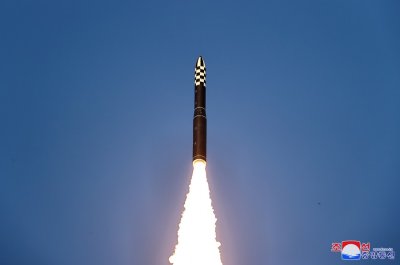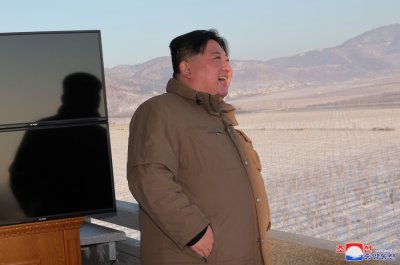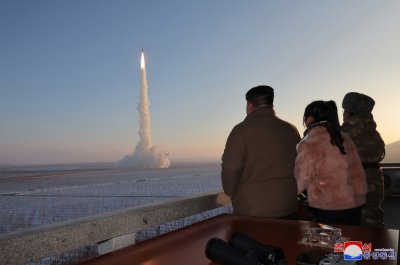North Korea on Tuesday published new images of its recent intercontinental ballistic missile launch, which was personally overseen by Kim Jong Un in an unmissable military signal meant for the United States and its allies.
North Korean state media said Pyongyang’s latest test of the Hwasong-18 missile, the largest in its arsenal, was a response to increasing U.S. hostility. The weapon is believed to have an operational range of over 9,000 miles, enough to deliver a nuclear strike on the American homeland.
Kim’s ballistic missile program is prohibited by U.N. Security Council resolutions and has resulted in his and his country’s ongoing international isolation. The ICBM launch on Monday followed North Korea’s test of a shorter-range ballistic missile the day before. Both projectiles splashed into the East Sea, also known as the Sea of Japan.
1 of 2
KCNA

KCNA

KCNA
The state-owned Korean Central News Agency released photographs that showed Kim and his daughter attending the launch event. Both were pictured observing the Hwasong-18 ICBM as it left the launch vehicle.
KCNA said the missile reached a maximum altitude of 6,518 kilometers (3,490 miles), taking it high into the atmosphere rather than horizontally over neighboring countries. The outlet said the rocket flew 1,002 kilometers (622 miles).
North Korea’s numbers were verified by defense officials in Tokyo, who recorded a 74-minute flight time, enough to extrapolate its operational range based on a standard missile trajectory.
“The ICBM-class ballistic missile launched this time, if calculated based on the trajectory and depending on the weight of the warhead, could have a range of more than 15,000 kilometers (9,320 miles),” said Miyake Shingo, Japan’s parliamentary vice minister of defense.
“In which case the whole of the U.S. territory would be within its range,” Miyake said.
The back-to-back tests in the North came as the U.S., South Korea and Japan activated a missile-tracking and data-sharing system. A joint announcement by the three allies on Tuesday said the system would help detect and assess Pyongyang’s missile launches in real-time.
It has been a record-breaking year for Kim’s missile launches, and since 2022, North Korea has tested more than 100 ballistic missiles, each with the intent of warning what it calls “hostile forces,” a placeholder for the South and the tens of thousands of American troops stationed there as part of U.S. Forces Korea.
In a pointed move of its own, the U.S. Navy dispatched the nuclear-powered fast-attack submarine the USS Missouri to the South Korean port of Busan over the weekend. The disclosure of the otherwise stealthy boat was Washington’s own way of demonstrating what it calls an “ironclad” commitment to defend Seoul and Tokyo against Pyongyang’s threats.
U.S. President Joe Biden warned earlier this year that a nuclear attack on South Korea would result in the “end” of Kim’s regime.
1 of 2

KCNA

KCNA

KCNA
A bullish KCNA said Kim expressed “great satisfaction over the results” of the latest launch, which it called “a practical demonstration of the actual condition and reliability of the formidable striking capabilities and absolute nuclear war deterrent possessed by the [Democratic People’s Republic of Korea’s] armed forces.
“He said that the launching drill sent a clear signal to the hostile forces, who have fanned up their reckless military confrontation hysteria against the DPRK all the year round and are frantically maximizing it till the end of this year despite the repeated stern warnings and denunciation by the DPRK,” the state news agency said.
Pyongyang promised “more offensive actions” in response to U.S. and allied deployments around the Korean Peninsula.
1 of 2

KCNA

KCNA

KCNA
North Korea continued its use of sharp language criticize the U.S.-South Korea alliance. Earlier this month, it accused Washington of “double standards” after U.S. officials rebuked Pyongyang for putting its first spy satellite into orbit—using the same ballistic missile technology frowned upon by the Security Council.
North Korea’s disapleasure, channeled through KCNA and other outlets, stemmed from the fact that the U.S. then assisted the South in launching its own reconnaisance asset into space—also Seoul’s first—shortly thereafter.
“It is said that a frightened dog barks noisier,” KCNA said of the U.S. criticism.
The Foreign Ministry in China, North Korea’s only treaty ally, described inter-Korean tensions as “complex.”
“The development of the situation fully proves that trying to solve the problem through military deterrence and pressuring will not work, and will only do the opposite and make the issues and tensions worse,” ministry spokesperson Wang Wenbin told reporters in Beijing on Monday.
“Dialogue and consultation is the fundamental way for settling issues on the peninsula.,” he said.
Uncommon Knowledge
Newsweek is committed to challenging conventional wisdom and finding connections in the search for common ground.
Newsweek is committed to challenging conventional wisdom and finding connections in the search for common ground.


